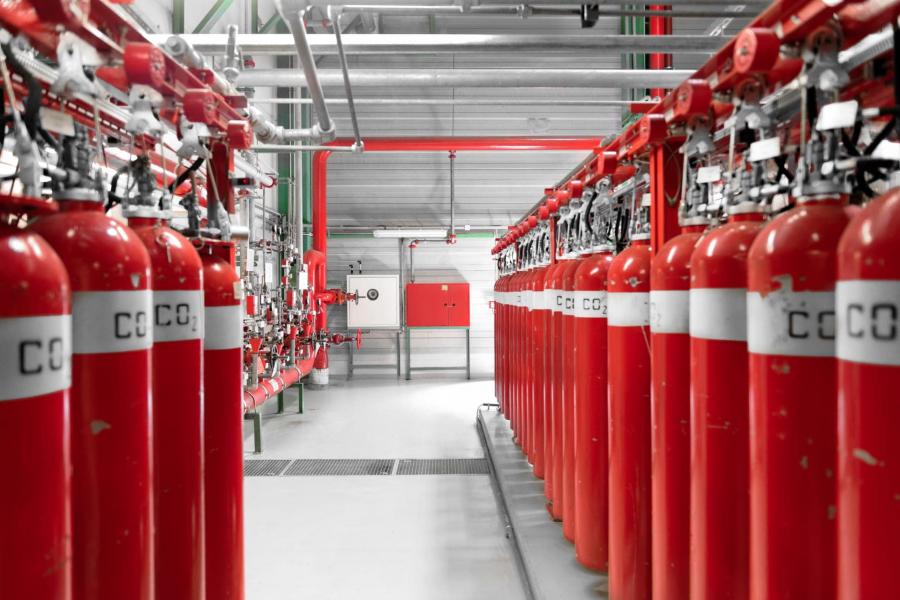
inspection and certification - extinguishing gas system
INTRODUCTIE BLUSGASINSTALLATIE
Bij het blussen van brand denken veel mensen misschien aan het gebruik van water. Maar water is niet altijd geschikt om brand mee te blussen. In dat geval zijn er blusgasinstallaties. Deze zijn heel geschikt om een brand te blussen wanneer water voor te veel schade zou zorgen. Dit is bijvoorbeeld het geval met computerruimtes en ruimtes met gevaarlijke stoffen. Ook kunnen blusgasinstallaties gebruikt worden voor het beveiligen van zaken als gasturbines en schakelkasten. En daarnaast wordt een blusgasinstallatie ingezet om brandrisico’s te beperken. Sommige verzekeraars stellen zelfs als harde eis dat er gebruik gemaakt wordt van blusgasinstallaties, al dan niet in combinatie met een systeem voor automatische branddetectie. Ook kan de overheid dit als voorwaarde stellen bij het verlenen van een bouw- of milieuvergunning.
Om ervan verzekerd te zijn dat de blusgasinstallatie voldoende bescherming biedt tegen het risico waartegen men zich wil indekken, eist men vaak een inspectiecertificaat van de installatie. Dat biedt de zekerheid dat de blusgasinstallatie niet alleen bij oplevering, maar gedurende de hele levensduur aan de eisen voldoet en dat deze de bescherming biedt die men er redelijkerwijs van mag verwachten.
TOEPASSINGSGEBIED BLUSGASINSTALLATIE
Blusgassystemen zijn vaak nodig om een bouw- of milieuvergunning te krijgen, bijvoorbeeld bij de voorwaarde ‘branddoorslag en brandoverslag’. Als de eindgebruiker bepaalde wensen heeft voor de plaatsing van het systeem, dan is dat geen probleem, zolang het niet in strijd is met de voorwaarden. Veiligheid gaat voor alles. In bijna alle marktsegmenten worden deze systemen gebruikt, zoals industrie, magazijnen met opslag van gevaarlijke stoffen en MER/SER-ruimtes.
NORMINHOUD
Nederland maakt voor de productie van blusgasinstallaties gebruik van buitenlandse voorschriften, zoals de CEA 4007; CEA 4008; CEA 4045; ISO 6183; NEN-EN 15004; NEN-ISO 14520; NFPA 12; NFPA 2001; VdS 2093; VdS 2380; VdS 2381. Voor brandmeldinstallaties, noodzakelijk voor de activering van de blusgasinstallaties, wordt NEN 2535 toegepast; voor ontruimingsalarminstallaties NEN 2575.
CERTIFICATIE CCV INSPECTIESCHEMA’S
Hoe ziet dit certificatietraject eruit? Inspecties kunnen plaatsvinden op afgeleide doelstellingen conform het CCV-inspectieschema Brandbeveiliging, waarna bij goedkeuring een inspectiecertificaat kan worden verstrekt. Daarnaast kan inspectie van blusgassystemen nodig zijn op PGS-locaties. Hierbij maken we gebruik van het CCV-inspectieschema Uitgangspuntendocumenten Brandbeveiliging Opslag Gevaarlijke stoffen volgens PGS (UPD-PGS) en het CCV-inspectieschema Brandbeveiliging Opslag Gevaarlijke Stoffen PGS.
RvA ACCREDITATIE
Bureau Veritas is door de Raad van Accreditatie geaccrediteerd voor het uitvoeren van inspectiewerkzaamheden onder registratienummer I 002, Type A onafhankelijke inspectie-instelling (zie ook RVA.nl). Dit geldt voor inspectie op afgeleide doelstellingen, inspectie op conformiteit met het UPD-PGS en inspectie op normconformiteit. Daarnaast voeren wij steekproefinspecties uit voor certificatie-instellingen.
INFORMATIE
Voor aanvullende informatie over dienstverlening en de toepassingsmogelijkheden kunt u rechtstreeks contact opnemen met de afdeling Brand op 088 4505670.